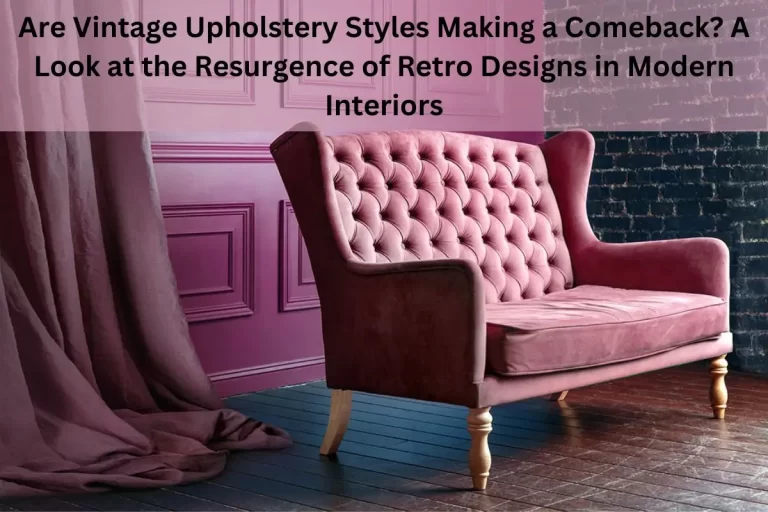Upholstery plays a crucial role in shaping the look and feel of any interior space. Beyond aesthetics, it contributes significantly to the functionality and comfort of furniture. A well-chosen upholstery fabric can elevate the design of a room while also serving practical purposes like durability and ease of maintenance. This blog explores the importance of upholstery in interior design, focusing on its functional benefits, contribution to style, and how it enhances comfort, providing insights into why it is a key element in creating a well-balanced and inviting space.
Maximizing Functionality: Upholstery as a Practical Design Solution
Upholstery is more than just a design element; it serves a functional purpose that directly impacts the longevity and usability of furniture. Fabrics like leather or microfiber are durable options for high-traffic areas, making them ideal for homes with children or pets. Upholstery also protects the furniture’s structural components from wear and tear, ensuring that it remains sturdy over time. Moreover, well-chosen fabrics can provide additional benefits such as noise absorption, contributing to a quieter, more comfortable living environment. Selecting functional upholstery ensures that furniture serves its intended purpose without compromising on quality or comfort.
Elevating Interior Style: How Upholstery Defines Aesthetic Appeal
Upholstery is a powerful tool in defining the style of a room. The color, pattern, and texture of fabric can dramatically alter the visual dynamics of any space. Bold patterns can act as a focal point, drawing attention to specific areas, while neutral tones blend harmoniously into minimalist designs. Texture also plays a critical role—plush fabrics like velvet add luxury, while natural fibers like linen offer a laid-back, casual vibe. Upholstery allows for customization, enabling homeowners to align their furniture with current design trends or opt for timeless styles that reflect personal taste, enhancing the room’s overall aesthetic.
 Comfort Redefined: Upholstery’s Role in Creating Cozy Spaces
Comfort Redefined: Upholstery’s Role in Creating Cozy Spaces
Comfort is a key consideration in any furniture choice, and upholstery plays a central role in achieving this. Soft, breathable fabrics like cotton and linen are ideal for living spaces where relaxation is a priority. Alternatively, materials like leather provide durability while maintaining a sleek appearance, though they may require additional cushioning for enhanced comfort. Upholstered furniture also supports ergonomics, offering the necessary cushioning for good posture and reducing physical strain. By carefully selecting the right upholstery, you ensure that your furniture not only looks great but also provides a comfortable, inviting space for family and guests.
Transforming Ambiance: Upholstery as a Mood Setter in Your Space
Upholstery has a significant impact on the mood and ambiance of a room. Soft textures, like velvet or chenille, create a cozy and inviting atmosphere, perfect for living rooms or bedrooms. In contrast, sleek materials like leather can give a more modern, polished look suitable for professional spaces. Beyond aesthetics, upholstery contributes to the acoustic quality of a room, with fabric-covered furniture absorbing sound and reducing echo. The right upholstery helps you set the desired tone for your space, ensuring that it feels warm, welcoming, and acoustically comfortable, aligning with the overall design vision.
Sustainability in Upholstery: Making Eco-Friendly Choices Matter
Sustainability is becoming increasingly important in interior design, and upholstery is no exception. Eco-friendly fabrics such as organic cotton, hemp, and recycled polyester offer stylish yet sustainable alternatives to traditional materials. These fabrics are produced using less energy and water, reducing environmental impact. High-quality sustainable upholstery also means longer-lasting furniture, which decreases waste and the need for frequent replacements. By choosing eco-conscious materials, you not only contribute to environmental conservation but also ensure that your furniture remains durable and aesthetically pleasing for years, combining sustainability with style.
 Top Upholstery Trends: What’s Making Waves in 2024
Top Upholstery Trends: What’s Making Waves in 2024
2024 is bringing exciting trends in upholstery that blend both innovation and style. Sustainable fabrics continue to gain popularity, with a focus on recycled and organic materials. Textures like velvet and bouclé are trending, adding a luxurious feel to furniture and home decor. Bold, geometric patterns and nature-inspired prints are in vogue, offering dynamic options for making a statement. Color palettes are shifting towards earthy tones like terracotta, moss green, and deep blue, reflecting a desire for natural, grounding elements. Staying on top of these trends helps keep your interior design fresh and forward-thinking.
Preserving Beauty: Essential Tips for Upholstery Maintenance
Proper maintenance is essential to keep your upholstered furniture looking its best. Regular cleaning is crucial—vacuuming or gently brushing the fabric prevents dirt buildup and keeps the material fresh. Stain-resistant treatments are a wise investment, especially for high-use areas, as they make cleaning spills much easier. Sunlight can cause fading and deterioration, so placing furniture away from direct sun or using UV-resistant treatments will help preserve fabric quality. Following these maintenance tips ensures that your upholstery remains vibrant, clean, and comfortable, prolonging its life and retaining the aesthetic appeal of your interior space.
Conclusion
Upholstery is a foundational element in interior design, contributing to function, style, and comfort. Its ability to enhance furniture durability, elevate the aesthetics of a space, and provide a comfortable seating experience makes it an essential consideration for any design project. By carefully selecting materials, paying attention to design trends, and maintaining upholstery properly, homeowners can create spaces that are both beautiful and practical. Upholstery isn’t just about fabric—it’s about creating an environment that reflects personal style while meeting the functional needs of everyday life.

 Comfort Redefined: Upholstery’s Role in Creating Cozy Spaces
Comfort Redefined: Upholstery’s Role in Creating Cozy Spaces Top Upholstery Trends: What’s Making Waves in 2024
Top Upholstery Trends: What’s Making Waves in 2024




